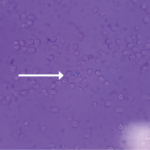 Katherine Yates, MD, completed her medical degree at Harvard Medical School and is an internal medicine resident at Vanderbilt University Medical Center, Nashville, Tenn. She is considering pursuing a rheumatology fellowship.
Katherine Yates, MD, completed her medical degree at Harvard Medical School and is an internal medicine resident at Vanderbilt University Medical Center, Nashville, Tenn. She is considering pursuing a rheumatology fellowship.
 Erin H. Penn, MD, received her medical degree from Jefferson Medical College in Philadelphia, completed her residency in internal medicine at Brigham and Women’s Hospital in Boston and is currently a fellow at Brigham and Women’s Hospital in rheumatology. Her areas of interest within rheumatology include nutritional, dermatologic and pulmonary-vascular manifestations of systemic rheumatologic disease. As a fellow, she is investigating the relationship between nutritional deficiencies and wellness in autoimmune disease, and associations between dermatomyositis and interstitial lung disease, while also training to be a clinician educator.
Erin H. Penn, MD, received her medical degree from Jefferson Medical College in Philadelphia, completed her residency in internal medicine at Brigham and Women’s Hospital in Boston and is currently a fellow at Brigham and Women’s Hospital in rheumatology. Her areas of interest within rheumatology include nutritional, dermatologic and pulmonary-vascular manifestations of systemic rheumatologic disease. As a fellow, she is investigating the relationship between nutritional deficiencies and wellness in autoimmune disease, and associations between dermatomyositis and interstitial lung disease, while also training to be a clinician educator.
 Minna J. Kohler, MD, is the director of the Rheumatology Musculoskeletal Ultrasound (MSKUS) program at Massachusetts General Hospital in Boston and an instructor in medicine at Harvard Medical School. Dr. Kohler has educational and research interests in point-of-care ultrasound and innovative imaging related to arthritis, crystalline disease, vasculitis and other musculoskeletal and rheumatic diseases. She provides specialized clinical care as part of the Massachusetts General Hospital Gout and Crystal Arthropathy Center.
Minna J. Kohler, MD, is the director of the Rheumatology Musculoskeletal Ultrasound (MSKUS) program at Massachusetts General Hospital in Boston and an instructor in medicine at Harvard Medical School. Dr. Kohler has educational and research interests in point-of-care ultrasound and innovative imaging related to arthritis, crystalline disease, vasculitis and other musculoskeletal and rheumatic diseases. She provides specialized clinical care as part of the Massachusetts General Hospital Gout and Crystal Arthropathy Center.
Takeaways
- Patients with renal failure are at risk for many forms of arthritis that can sometimes be clinically indistinguishable.
- Clinicians should have a high index of suspicion for oxalate arthropathy in patients with long-standing renal failure or who are on hemodialysis. Consider oxalate levels and obtain synovial biopsy with alizarin red staining to confirm the diagnosis.
- Although gout is a common crystalline arthropathy associated with chronic kidney disease, imaging with clinical correlation can help distinguish crystal etiology when joint effusion/tissue is not available for analysis. Oxalic acid arthropathy is not necessarily distinguishable on imaging alone.
- Determining high levels of oxalate can help promote modification of hemodialysis regimens and avoid inappropriately treating patients for other types of arthritis, such as gout.
References
- Bardin T, Richette P. Rheumatic manifestations of renal disease. Curr Opin Rheumatol. 2009 Jan;21(1):55–61.
- Dalbeth N, Stamp L, Merriman T. (2016) Gout. Oxford: Oxford University Press.
- Lorenz EC, Michet CJ, Milliner DS, et al. Update on Oxalate Crystal Disease. Curr Rheumatol Rep. 2013 Jul;15(7).340.
- Terkeltaub R. Gout and Other Crystal Arthropathies. Philadelphia: Elsevier Saunders, 2012.Reginato AJ, Seoane JLF, Alvarez CB, et al. Arthropathy and cutaneous calcinosis in hemodialysis oxalosis. Arthritis Rheum. 1986 Nov;29(11):1387–1396.
- Rathi, S, Kern W, Lau K. Vitamin C-induced hyperoxaluria causing reversible tubulointerstitial nephritis and chronic renal failure: A case report. J Med Case Rep. 2007 Nov 27;1:155.
- Naredo E, Lagnocoo A. One year in review 2017: Ultrasound in crystal arthritis. Clin Exp Rheumatol. 2017 May–Jun;35(3):362–367.
- Choi MH, Mackenzie JD, Dalinka MK. Imaging features of crystal-induced arthropathy. Rheum Dis Clin North Am. 2006 May;32(2):427–446.
- Jablonski KL, Chonchol M. Vascular calcification in end-stage renal disease. Hemodial Int. 2013 Oct;17 Suppl 1:S17–21.
- Milliner DS, Eickholt JT, Bergstralh EJ, et al. Results of long-term treatment with orthophosphate and pyridoxine in patients with primary hyperoxaluria. N Engl J Med. 1994 Dec 8;331(23):1553–1558.
- Mulay SR, Kulkarni OP, Rupanagudi KV, et al. Calcium oxalate crystals induce renal inflammation by NLRP3-mediated IL-1β secretion. J Clin Invest. 2013 Jan;123(1):236–246.

